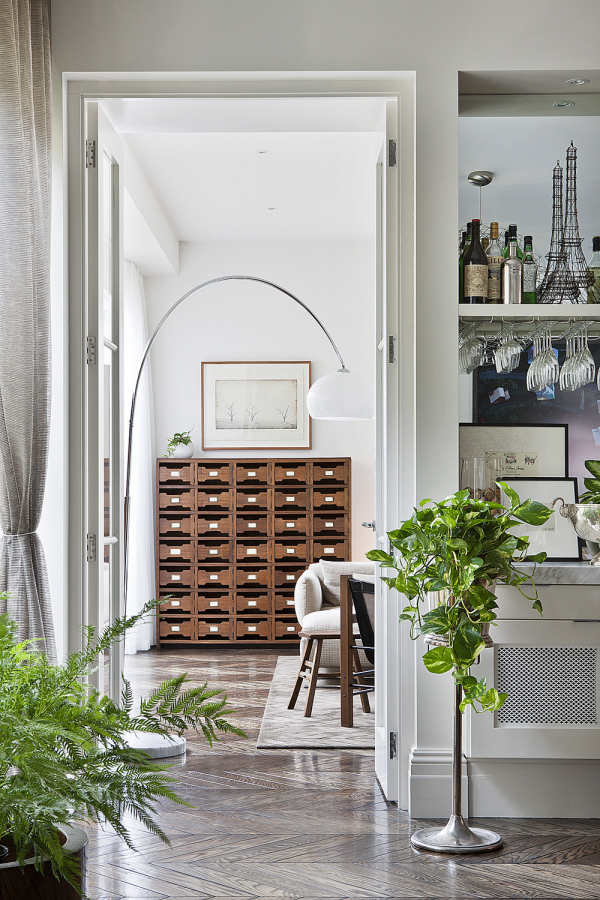








Image Credit : Shannon McGrath

Project Overview
The neoclassical façade of this Toorak residence divulges nothing of the building’s interior, which is a journey into the unexpected. Taking its cues from the building – “I’m new but I want to be old” – the contemporary interior authentically observes the past. Modern art, heirloom furniture and imported lighting hover in style and time.
The ground floor is a tale of two worlds. Cross the threshold and be transported, Alice in Wonderland style, to a choice of the Salon (glamour/public) or the Living Room (family/private).
Part palace, part bazaar and part Miss Havisham’s house, the Salon is a grand, luxurious room that takes seriously its ‘private hotel’ aspirations. A fabulous bar sits alongside lushly upholstered custom furniture and major contemporary artworks. The Salon is about glamour, excitement and aspiration; its look is fun, strong and idiosyncratic.
With milder manners, the Living Room is serene and provides the backdrop for daily life. While the colours and textures dial back from the Salon, the careful curation of varying objects retains the furnishing approach.
Upstairs, bedroom suites and an elegant study deliberately retreat from the energy of the ground floor.
Project Commissioner
Project Creator
Team
Anja de Spa, Architect
Richard Fleming, Architect
Jarrod Haberfield, Architect
Project Brief
Our clients desired a home that would offer two experiences – comfort, beauty and relaxation for family life, alongside excitement and energy for social life. And they were explicit that the interior avoid the mild safety or minimalism typical of Melbourne’s leafy inner South-East.
Project Need
The house is a reproduction period house – a new building trying to look old – and typically in Toorak these are furnished with reproduction period furniture.
Our decision was to sidestep this farce.
We announced to the building, “We’ll ignore your newness and treat you as the fin-de-siecle edifice you purport to be. Let’s do a contemporary interior that references your supposed oldness.”
A combination of real antiques is deliberately juxtaposed with new pieces that draw from history with an explicit wink. The immediate statement is that this is not a typical Toorak home, and unquestionably transports the visitor to an alternate reality that feels miles from the street outside.
The direction is in tandem with that of contemporary furniture designers – Maarten Baas, Phillipe Starck and Patricia Urquiola among them – whose featured pieces take historical models and twist them.
Tom Dixon’s wingback chair in royal blue velvet recasts the 18th-century classic British gentleman’s chair. The custom rug offers another contextual wink to the observant, as does a one-off three-legged table from Barbera that feels at once contemporary and vintage.
Against a wall of custom joinery and full-height glazing, a new sofa joins Eames classics – a 1970s armchair and a 1930s Japanese slipper cabinet – furnishing a look that hovers in style and time.
Underpinning the atmosphere and contrast of experience desired by the client is an extraordinary art collection. Intriguing, inspiring or sumptuously decorative, artworks are used throughout the interior to enhance the palette of each space, and to surprise and confound.
Design Challenge
In a word: pitch.
When orchestrating an interior for a journey into the unexpected, the risk is creating a stage set, and not an environment for living. The challenge was finding a way for the ‘twist’ to be mild enough for the environment to remain supportive and not subversive.
In volumes as grand as these, we rely on the fine grain of decoration to give it human scale and tactility. Decoration takes responsibility for rewarding the act of slowing down or stopping. From every chair is a view worth taking in.
Decoration emerges from our design approach, illustrated in the Salon. A two-sided custom banquette resolves the two axes in the room, between the sitting and dining areas. Interior design extends as far as the bar, but it is the decoration – the bottles, decanters, glassware, silverware and framed memorabilia – that instils the bar’s magnetic attraction.
Comfort comes in the form of careful art direction: objets with history, curated plants and flowers. The spaces facilitate every home experience, from on-sofa reading to a seriously chic soiree. What, if not this, is a home for?
Sustainability
Much of the furniture is recycled; some in unchanged state (such as the Japanese slipper cabinet), while other pieces have been renovated (such as the re-covered pair of thrones).
All fabrics are 100 per cent natural: wool, linen and cotton.
Low VOC paints and urethanes have been used.
Interior Decoration
This award recognises building interiors, with consideration given to furnishings, finishes and aesthetic presentation. Please specify furnishings lighting, flooring, colours and fabrics.
More Details

